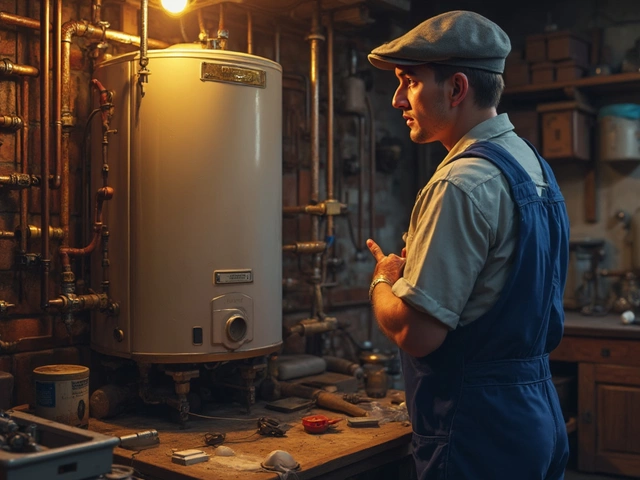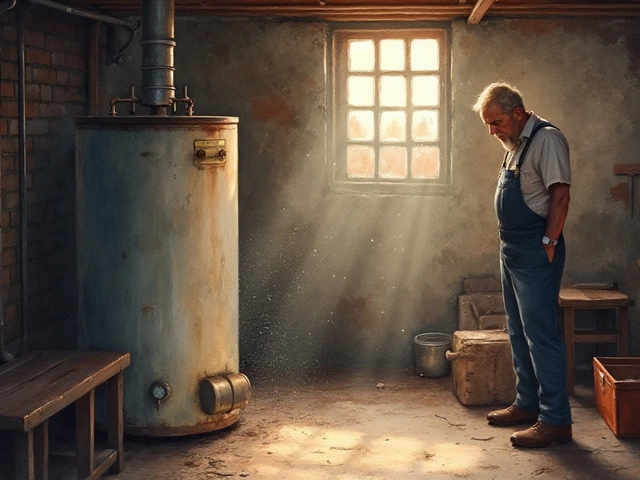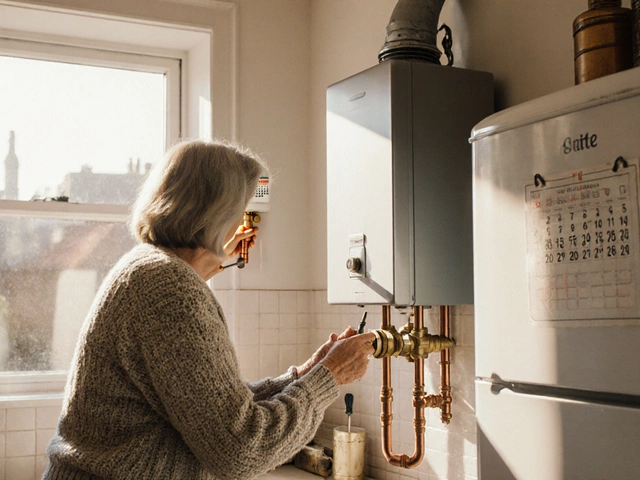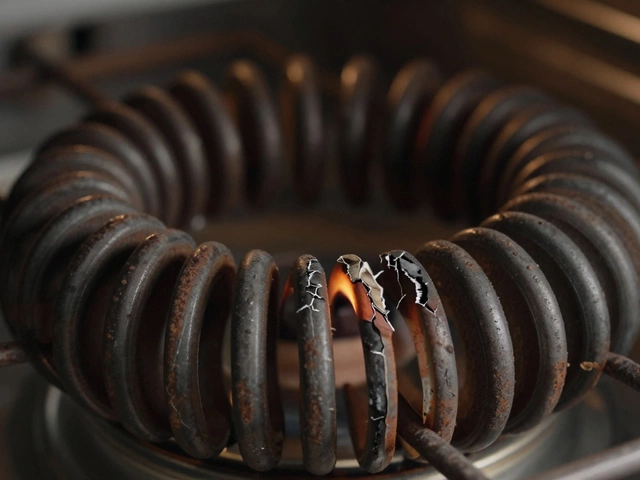Water heaters, the unsung heroes of modern comfort, often go unnoticed until they're on the fritz. Knowing where these vital appliances commonly fail can save you a cold shower and a heavy service bill.
From malfunctioning heating elements to a corroding internal tank, there are a few notorious components that tend to cause trouble. Identifying these key areas can be your first step in keeping the hot water flowing smoothly. Take the time to understand these potential problems so you can tackle them head-on or prevent them altogether with a bit of foresight.
Let’s dive into the nitty-gritty of what makes water heaters tick—and where they tend to trip up.
- Understanding the Basics of Water Heaters
- Heating Elements: Frequent Culprits of Failure
- The Internal Tank: Signs of Wear and Corrosion
- Pressure Relief Valve: Why It Matters
- The Role of the Thermostat in Performance
- Maintenance Tips to Prevent Common Failures
Understanding the Basics of Water Heaters
Water heaters are a central component of most homes, providing a continuous supply of hot water at the twist of a tap. These appliances, often tucked away in basements or utility rooms, might seem unassuming, yet they perform an essential role in daily comfort. At its core, a water heater's job is to heat water efficiently and consistently for household use, which can range from showering to cooking or cleaning. Most water heaters achieve this through a tank that stores and heats water, or by heating water directly in tankless models. Knowing the basic structure and function of these systems is crucial for understanding where problems can occur and how they can be prevented.
The two main types of water heaters commonly found in homes are storage water heaters and tankless water heaters. The former, as the name suggests, involves a tank that stores heated water until needed. These tanks range in capacity, typically from 20 to 80 gallons, depending on the needs of the household. As water is heated, heat rises to the top of the tank, delivering hot water on demand. On the other hand, tankless or on-demand water heaters heat water directly without the use of a storage tank. When a hot water tap is turned on, cold water travels through a pipe into the unit where either a gas burner or an electric element heats the water.
Key Components of a Water Heater
Each type of water heater has several key components that enable its operation. Understanding what these components are and how they function is key to recognizing signs of wear or malfunction. In storage water heaters, one might find dip tubes, water inlets and outlets, a heating mechanism powered by gas or electricity, as well as safety features like temperature and pressure relief valves. These components must function together harmoniously to ensure the heater operates safely and effectively. A malfunction in any part can result in a failure to provide hot water or even lead to leaks or other damage.
Regular maintenance is vital in keeping a water heater working efficiently. Flushing the tank periodically can remove sediment build-up, which improves efficiency and extends the life of the heater. Consulting the manufacturer's manual provides specific guidance on how and when to perform maintenance checks. Surprisingly, according to a study by the Water Heater Research Association, regular maintenance can increase the lifespan of water heaters by 20% on average.
"Quality water heaters are designed to operate efficiently for 8–15 years with proper maintenance," notes industry expert, Dr. Helen Watterstone. "The key is preventative care, addressing issues before they escalate."
Heating Elements: Frequent Culprits of Failure
When it comes to the frustrating issue of a malfunctioning water heater, the heating element frequently takes center stage. These components are the backbone of most water heating systems, responsible for turning electrical energy into the heat that warms the water stored in the tank. Naturally, their over-reliance makes them prone to wear and damage over time. From the gradual build-up of sediment around the element itself to electrical malfunctions, these problems can cause the heating element to be one of the most common sites of failure in your trusty water heater system.
Heating elements come in a variety of shapes and designs, usually either straight or looped. The design may seem irrelevant at first glance, but it can influence how sediment settles around it. In areas with hard water, sediment build-up becomes a more significant issue, as minerals dissolved in the water gradually settle and harden around the base of the element, insulating it and reducing its ability to effectively heat the water. Therefore, regular maintenance and cleaning of the tank can prevent these sediment-related issues and potentially extend the life of the heating element. Routine draining and flushing of the tank will remove accumulated minerals, thus saving you from the grief of a cold shower.
Spotting Heating Element Problems
Diagnosing a faulty heating element can sometimes feel like a detective game. First, pay attention to the symptoms. If you notice that your water is taking longer to heat or if the hot water runs out faster than usual, it may be due to the heating element malfunctioning. An unexpected spike in electricity bills can also signal that the element is straining under the weight of mineral deposit build-up, forcing it to use more power than necessary. To confirm, you can use a multimeter to test for continuity in the element. If the reading falls outside of the expected range, replacement of the element will likely be required.
Replacing a Heating Element
The process of replacing a heating element is relatively straightforward, albeit with some caution needed as you'll be working with electrical components. Begin by cutting off the power supply to the water heater from your home’s main electrical panel. Next, drain the heater tank to access the internal components. Unscrew the faulty heating element and replace it with a new one, ensuring a tight seal to prevent leaks. Finally, refill the tank, restore power, and test the water temperature after a few hours. If all is well, you'll have a working heater again.
"Regular maintenance of the heating elements in your water heater is crucial to sustaining the efficiency and longevity of the appliance," notes the Water Heater Manufacturers Association.
By regularly checking and maintaining the heating elements in your water heater, homeowners can avoid many common pitfalls, keeping their showers steaming hot and their wallets happy. Taking these proactive steps ensures that you won't have to share your morning rush with unexpected surprises, maintaining the warm comfort we often take for granted every day.
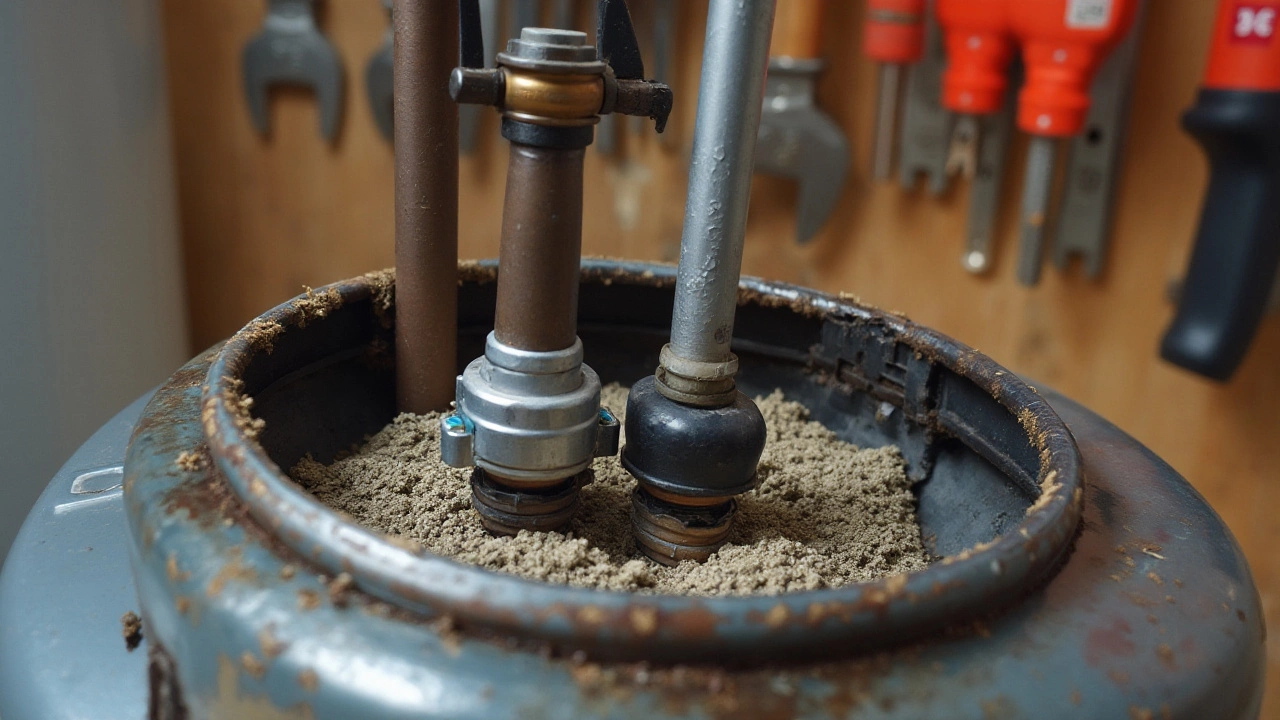
The Internal Tank: Signs of Wear and Corrosion
The internal tank of a water heater is its beating heart, holding and heating the water that keeps your showers warm and dishes clean. But like any hardworking component, it's not impervious to wear and corrosion. These tanks, often constructed from steel and lined with a glass coating to prevent rust, can develop flaws over time. A more vigilant approach can help identify signs of trouble early.
Corrosion is the primary nemesis here, often sneaking up as the glass lining is compromised. Look for telltale signs such as rusty water coming from your taps. This might indicate the steel itself is beginning to rust, meaning the tank could be on borrowed time. Another clue is water pooling beneath the heater, indicating possible leaks. Fixing a corroding tank isn't just about patching holes but understanding that it might need replacement soon.
One effective countermeasure is the regular inspection of the anode rod, a sacrificial element designed to attract corrosion and safeguard the tank. Checking and replacing this rod every few years can significantly extend the life of your water heater. Sudden increases in energy bills can also be a subtle whisper that your water heater's internal tank is struggling, as it might be working harder to maintain the same temperature with failing integrity.
As John Simmons, a veteran plumber with over 25 years of experience, says, "A little maintenance goes a long way. Keep an eye on your anode rod, and you'll keep the rust at bay."
Interestingly, the statistics tell a story as well. Reports suggest that 70% of water heater failures stem from internal corrosion. This stark number underlines the importance of attentive care. Stay proactive by scheduling regular inspections, keeping an eye on water color, and ensuring your system isn’t battling leaks. A water heater's lifespan varies widely, depending on maintenance quality. With due diligence, you can often stretch its service by several years, savoring warm showers for longer without unexpected replacements.
Pressure Relief Valve: Why It Matters
In the heart of every trusty water heater exists an important yet humble component known as the pressure relief valve. Serving as the system’s watchdog, this small mechanism wields big responsibility. It acts as a guardian against over-pressurization which can lead to catastrophic appliance failure. Think of it as your water heater's safety net, diligently ensuring that the internal pressure does not exceed a safe level. This is crucial because, during the normal operation of your water heater, the pressure of water inside can vary. Factors such as temperature fluctuations and incoming water pressure contribute to this constant change. The valve’s job is to release water in order to drop the pressure if it goes beyond the set limits.
The role of the pressure relief valve becomes even more critical when you consider what could transpire if it failed. A malfunction can result in potential damage and presence of danger in your home. It’s not merely about stopping a dribble of water, but preventing a geyser-like effect with dangerous scalding hot water gushing where it shouldn’t. According to the Insurance Institute for Business and Home Safety, water heater failures cost an average of $4,444 per claim. But more than the cost, it’s the safety of the household that stands on the line. It's like having a fire extinguisher that's non-operational during a fire – a situation no homeowner would wish upon themselves.
Regular checks on this valve can save a lot of hassle. It’s shockingly simple to do what’s necessary and extend the life of your water heater. To test the pressure relief valve, you can lift the valve lever slightly and let water flow through the dedicated discharge pipe. You should hear water exiting and see it flowing, verifying that the valve is not clogged or stuck. If it doesn’t work as expected, it’s time to have it checked by a professional, ensuring your water heater repair goes on smoothly and efficiently. And remember, a pressure relief valve is expected to be replaced every 3 to 5 years as part of proper home maintenance. This is a relatively inexpensive way to ensure safety and keep your water heater functioning optimally.
If contemplating DIY approaches is not within your comfort zone, don't hesitate to reach out to professionals specializing in water heater repair. They possess the skills and knowledge to judge and replace this critical component correctly. It's always better to be safe than sorry when it comes to matters as crucial as this.
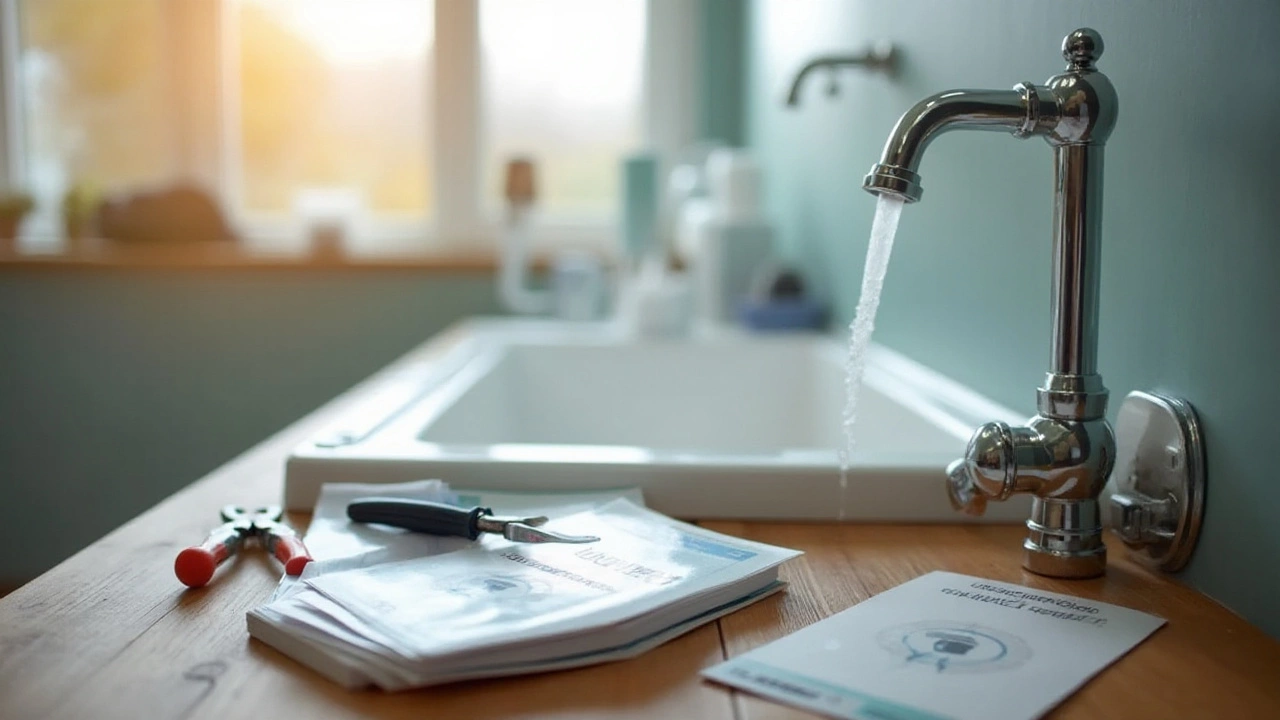
The Role of the Thermostat in Performance
When you're standing in the shower, enjoying that blissful hot water, have you ever stopped to think about the role of the thermostat in your water heater? This small but mighty device is at the heart of maintaining just the right temperature. Without it, you could find yourself suddenly facing an icy blast. The thermostat is essentially your water heater's brain, constantly measuring the water temperature and deciding when to heat more. A faulty thermostat can mean the difference between luxurious warmth and shivering cold.
A water heater typically houses two thermostats: a top and a bottom one. This dual setup is crucial because it ensures that the heater works efficiently, managing water temperature across the whole tank. The thermostats communicate with the heating elements, telling them when to turn on or off. So, when a thermostat malfunctions, it's often the root cause of several common issues like inconsistent temperatures or a complete lack of hot water. Checking these components regularly can help avoid bigger problems down the line.
Did you know that setting the thermostat to the recommended 120 degrees can help prevent scorching and reduce energy use? This temperature setting strikes a balance between comfort and safety. A higher setting can waste energy and could even cause scalding injuries. Interestingly, according to a study by the U.S. Department of Energy, lowering your thermostat by 10 to 15 degrees when the house is unoccupied can save around 5-15% a year on heating bills.
A specialists at Energy Star once stated, "Proper thermostat management is one of the easiest ways to improve your home's energy efficiency."Maintenance and regular checks are vital. If you notice your water isn't getting hot enough or it's much hotter than usual, a thermostat inspection might be in order. Replacing a thermostat isn't all that complicated for those with some DIY skills, but for others, calling a professional to ensure it's done safely is a wise choice.
Signs of a Failing Thermostat
If your thermostat is struggling, the symptoms can be quite telling. Maybe you've noticed that the water temperature is unpredictably swaying from warm to cold, or perhaps it never reaches the temperature you desire. Occasionally, this could result from sediment build-up obscuring the thermostat’s ability to accurately read the tank’s temperature. Other indicators include the heater running constantly, driving up energy bills without delivering the heat, or the heater not activating at all. By recognizing these signs early, you can mitigate the risk of complete water heater failure.Regular maintenance should include checking the thermostat settings and making sure they haven't slipped. A quick adjustment might solve minor issues. However, if you attempt a fix yourself, remember to always turn the power off at the breaker to prevent any danger. If the problem persists, enlisting professional help to evaluate both the thermostat and heating elements can pave the way for quickresolution and continued comfort.
Maintenance Tips to Prevent Common Failures
Keeping a water heater in top condition involves regular maintenance. Simple steps can extend its life significantly and reduce the chances of sudden failures. Start by making it a habit to flush your water heater at least once a year. This process removes sediment that builds up at the bottom, which can affect efficiency and lead to critical weaknesses in the tank. To do this, turn off the power and cold-water supply, attach a hose to the drain valve, and lead it outside or to a drain. Open the valve and let the water (and sediment) flow out. When you see only clear water, you're done. Remember this simple routine to keep things running smoothly.
Regularly Examine the Pressure Relief Valve
The pressure relief valve is a small component but plays a big role in your water heater's safety. Its purpose is to release pressure that might build up inside the tank, preventing a possible explosion. Test it twice a year by carefully lifting the lever and letting it snap back. A burst of hot water should flow into the drainpipe. If nothing happens or there's a constant drip afterward, you might need to replace the valve. Keeping this valve in working order is crucial for the safe operation of your heater and can help avoid costly damages.
Mind the Thermostat Settings
The thermostat doesn't just control your water temperature; it's key to energy efficiency and preventing overheating. Most manufacturers set the thermostat to around 140 degrees Fahrenheit, but you can lower it to 120 degrees without much impact on your hot water experience. This small adjustment reduces energy bills and also slows down internal corrosion. Adjusting is simple—turn off the power, remove the access panel and insulation, and use a screwdriver to set your desired temperature. It’s a small tweak that offers big benefits and is well worth considering.
- Inspect Annually - Look for visible signs of wear or rust.
- Check the Anode Rod - Every three years, make sure the anode rod isn’t corroded. It sacrifices itself to prevent tank corrosion.
- Evaluate Connections - Tighten loose connections but be careful not to over-tighten and damage the tank.
Statistics indicate a well-maintained water heater can last longer by up to 30% compared to those ignored. This not only saves money but also ensures you and your household enjoy a steady supply of hot water. Planning and simple maintenance actions bring peace of mind and invaluable assurance that a little care today prevents big problems tomorrow.



